Any work geared toward tangible results should begin with the creation of a plan. In this case: From a content plan, also known as a content plan. Once you have a content plan, then write or commission a copywriter to write effective content yourself, optimized for SEO. All this is done to show up higher in Google search results and increase traffic to your site.
If you are wondering:.
- is it worth creating a content plan,
- how to do it quickly and painlessly,
- how to prepare an assignment for a copywriter based on proven data,
- and most important: how, by publishing content based on a solid content plan, to get more traffic to your wristwatch site,
.
.
.
.
then read on. We’ll address each of these issues in turn.
Content plan – why make one?
Content plan, which we will discuss here, is aimed at publishing SEO-optimized texts. Once you have such content on your site, you just have to wait for Google to “get it” and start showing it high in search results. Then you can rake in new traffic to the site, some of it probably from competitors.
Gradually filling in your content gap, i.e. the content gaps on your site, you will occupy better and better search engine positions. And from there, it’s only a step to more sales.
There are at least a few benefits that come with a well-made, data-driven content plan:
- You are not operating on intuition, which is mostly not a very good advisor when it comes to creating business-effective content,
- You significantly increase the chances that the time and money you invest in content for your site will not go to waste,
- You have clear guidelines to give to the copywriter and it is easier for you to monitor whether the work has been done as ordered,
- Psychological benefits we can include a reduced sense of chaos, greater clarity and the resulting peace of mind: you know specific steps, you know what to publish, the future becomes more predictable.
.
.
.
.
If you’d like to see how data-driven content planning can increase website traffic, read our case study from our collaboration with OstroVit.
Content planning yesterday and today
.
How to create a content plan? In order to achieve the best results with your content – that is, to show up high in Google and draw more traffic to your site – you should first analyze your keywords, your competition and your situation in the SERPs (Google search results).
SEO specialists or content managers usually use several tools for this process, or at least several modules within one tool. For example, in Senuto you can use Keyword Database to check the statistics of the phrases, and on top of that Visibility Analysis and SERP Analysis to discern the competitors and screen the articles that rank high.
With the tool, you complete the data, analyze it and it comes up with what articles you should put on your site: what topics, using what keywords, what length, and so on. You come out with a content plan, that is, a content plan.
Creating such a content plan is quite a time-consuming process. Effective, if well guided – but time-consuming and not easy overall.
Can you simplify it? Are you able to create a content plan that works quickly, without much effort or expertise?
Yes, you are, and in this article I will show you how to do it.
I realize that this may sound like an advertising slogan like “Discovered the magic way to make money and not make money! Entrepreneurs hate him!” – but I hope it will soon become clear what this “magic way” is all about and that everything is done in accordance with art and good manners.
You will need access to the Senuto application. If you don’t have it yet, sign up for an account on 14 for free. In the app you will find the Content Planner tab. It’s what we’re going to play with today.
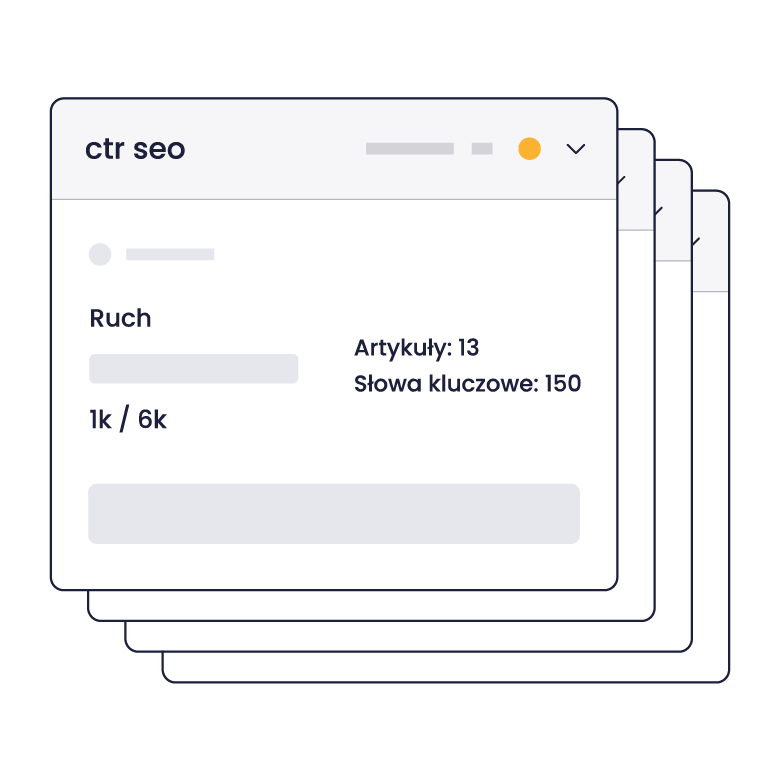 .
.
How to have the best positioned wristwatch website
.
Before we get to the actual steps, let’s turn on our imagination for a moment.
You are the person partly responsible for the results of the thriving e-commerce site Watch.net.
Take your pick – you could be:
- .
- The owner of this business,
- Marketing manager,
- SEOwner,
- Content manager,
- SEO copywriter or team leader in a team of copywriters,
.
.
.
.
.
It’s less important which of these roles you fill, more important is the task ahead of you:
You have to make it so that by publishing relevant content on the site you can increase its visibility on Google and thus bring more organic traffic to the site..
The reasons why we will work on the example of the Watch.net store are quite mundane.
1. everyone likes wristwatches. Or at least I do, and I somewhat assume that this feeling is universal. If you don’t like wristwatches, then close your eyes and think of other items you like. The rules for creating content plans will be the same.
2 The second reason is that the Watch.net website ranked 76th in our last year’s “E-commerce in Poland 2021” ranking. The position in the TOP 100 most visible online stores is still a very good result… but not as good as that of another watch e-store: Zegarownia.pl, which snagged the 49th position.
So there is someone to fight with and something to fight for.
Zegarownia, being the best-positioned Polish watch store, cannot settle on its laurels. SEO is a project that basically has no end, because once a position is taken, it is never given forever.But it is the Zegarek.net site further down the ranking that has more to win and therefore – more work to do..
So here goes.
How to create an effective content plan
.
You probably already know that by publishing anything on the subject of watches, you are unlikely to achieve impressive results. The content you prepare must be very targeted. So, not only meet the basic principles of SEO, but also be designed based on external and internal considerations.
- External conditions means your competition and the situation on Google: what who has published on their site and how it ranks in the search engine.
- Internal considerations obviously intersect with external ones, and indicate the content you already have on your site, and the potential you still have to exploit (i.e., what else you need to publish on your site to help new users come to it).
We’ll examine both types of considerations using the Content Planner, and then generate an effective once-two plan: a set of topics and guidelines for articles that should appear on Watch.net.
Match keywords and competitors
.
To start with, let’s deal with keywords. Most site owners or managers have at least some idea of what keywords they want to position themselves for. At a minimum, it’s enough to start with the categories on the site. In the case of Watch.net, they look like the following:
 .
.
View after expanding the menu on the Watch.net website
.
If you want, enter your own keywords, fleshed out in the process of research (more or less deep), into the Content Planner. However, you might as well use the automatic suggestions that the tool will give you. That, by the way, is one of the main ideas behind Content Planner: to automate keyword research and thus save you time.
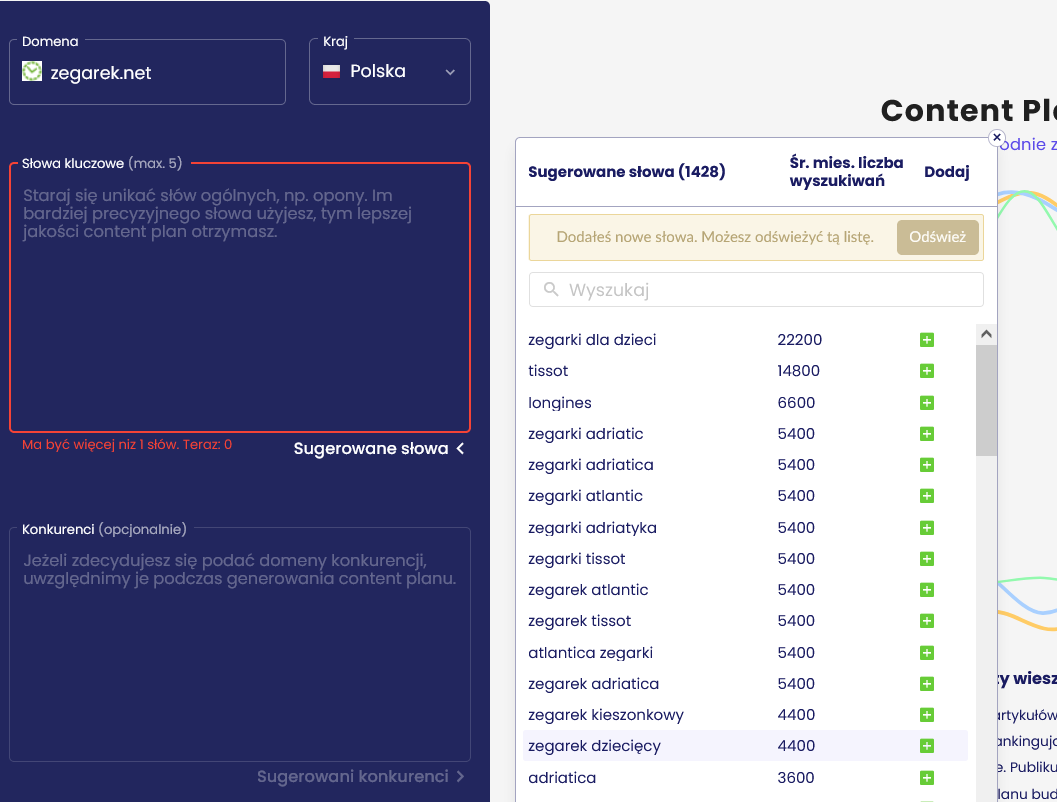 .
.
In addition to the keywords, there will still be competitors to type into the Content Planner. Let’s take a quick glance at Google search results after typing in the phrase “wristwatch.”
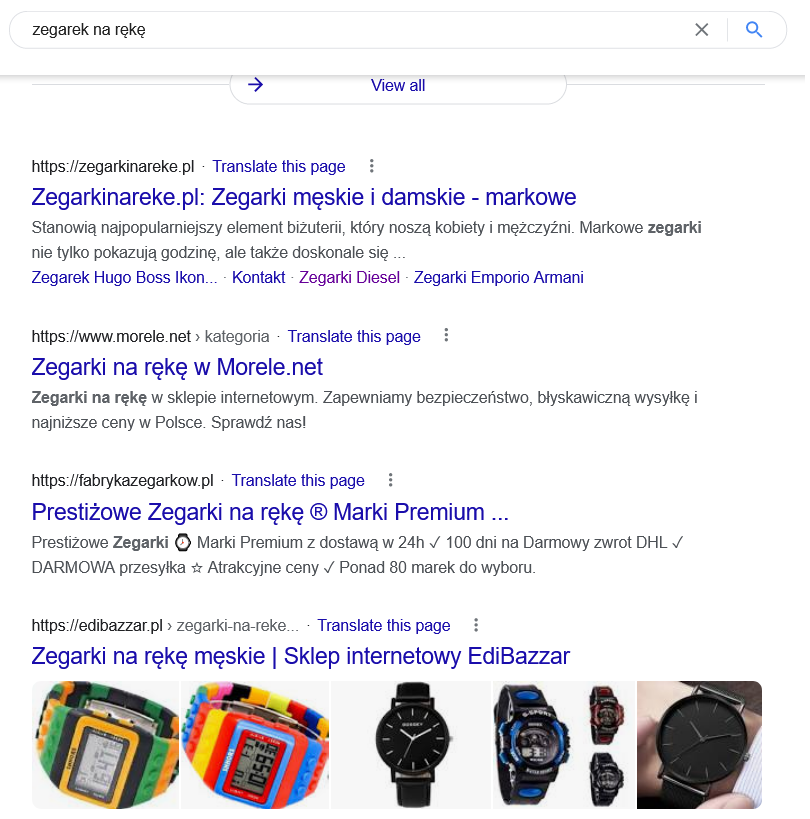
This way we can pick out at least a few competitors. Of course, you may be tempted to do a slightly more advanced analysis of the competition, but as a preliminary study – such a procedure will suffice.
Competitors are also very well suggested by the Content Planner itself. All you have to do is click “Suggested competitors”.
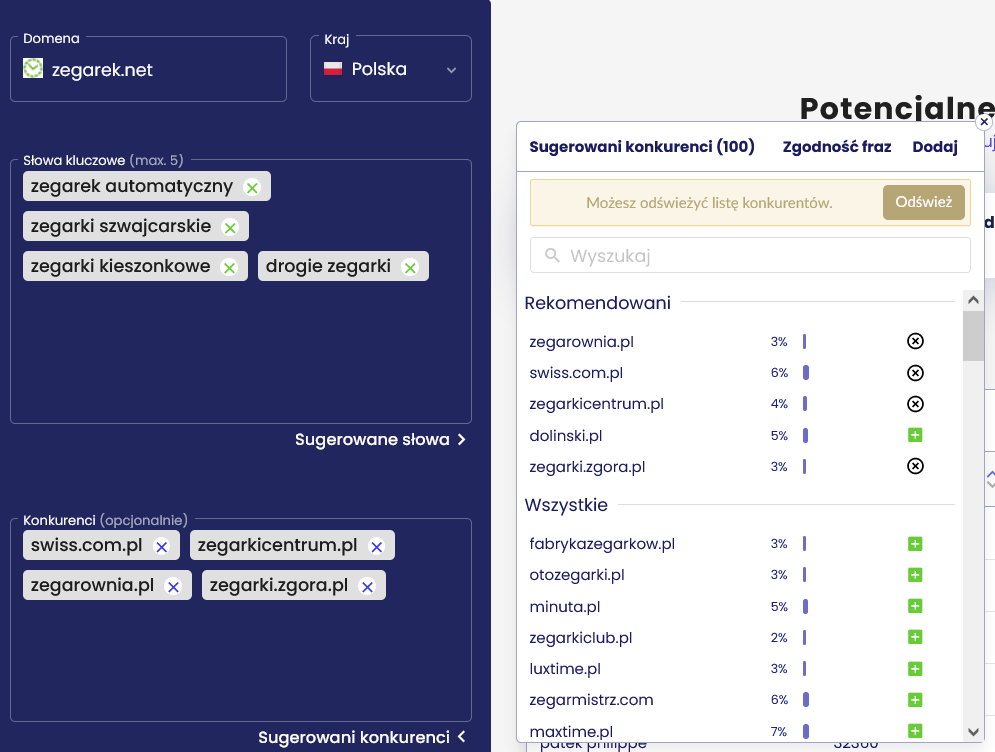 .
.
So I have a set of keywords that interest me:
- automatic watch,
- Swiss watches,
- pocket watches,
- expensive watches
.
.
.
.
I was partly inspired by the menu on the Watch.net website, and partly I used the Content Planner’s automatic prompts, where I additionally have the average monthly number of searches for a given phrase taken into account (thanks to this, I added, for example, “expensive watches” to the list – there is no such category in the store, and the automatic prompts showed that this phrase records 590 searches per month).
Competitors:
- swiss.com.pl
- zegarkicentrum.pl
- zegarownia.pl
- zegarki.zgora.pl
.
.
.
.
Again, I partly benefited from my own very basic research, and partly from Content Planner’s prompts.
Here is what list of articles I obtained:
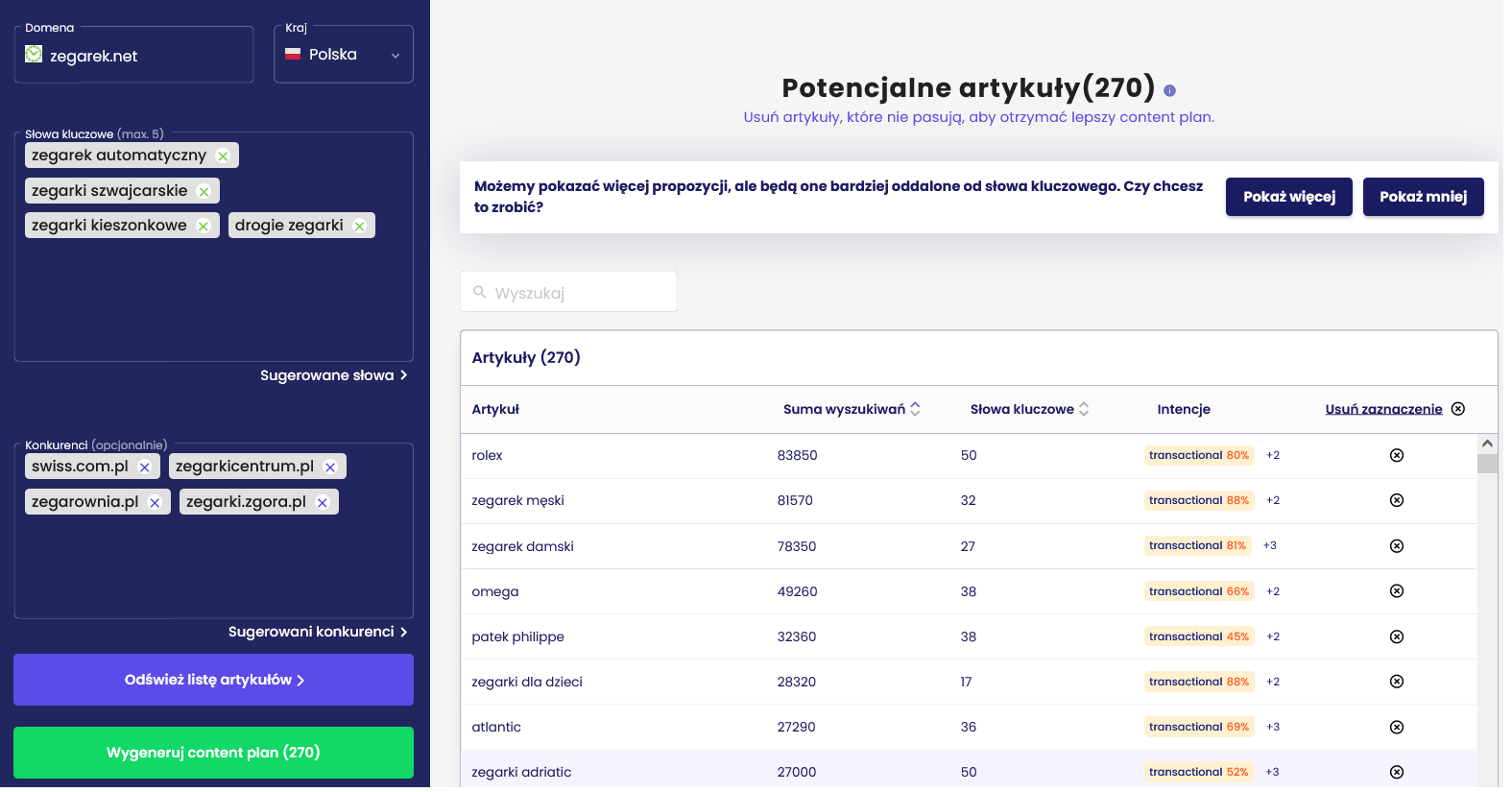 .
.
Important note: this is not yet a content plan!
What I got from Content Planner at this point is a general list of topics that can be included in a proper content plan.
If I think certain items on this list don’t interest me, I can remove them manually or select “Show less” for a narrower fit.
What do I delete from the list?
- Phrases related to children’s products, such as “watches for kids“, “watch for a 7-year-old girl” or “watches for casio girls” – do not intrigue me for now. But the generated list of topics drew my attention to the fact that users often look for information on watches for children and teenagers – I hadn’t thought of that before. Perhaps the next content plan I will invent with such phrases in mind.
- “Watchmaker wrocław” and other phrases related to local intent, as we are primarily concerned with website hits, not stationary store visits. Content Planner divides keywords by 4 types of intent: transactional, research, local and navigational. It’s useful to know which ones interest us the most at a given moment.
- “Men’s watch replicas“, “men’s clock sleeve tattoo“, “watch refurbishment” and other phrases that are not related to the store’s offerings.
.
.
.
Such sifting ensures that the content plan won’t include topics I don’t want to rank for on Google (at least for the moment), and the content I commission or create will be more to the point.
Now we are ready to move on to the next step.
Generate the right content plan
.
A few minutes passed. It grinded, it lurched, and there it is: the finished content plan, created from the ingredients given earlier. (Generating by default takes about 5 minutes, in cases of high server load you have to wait up to half an hour).
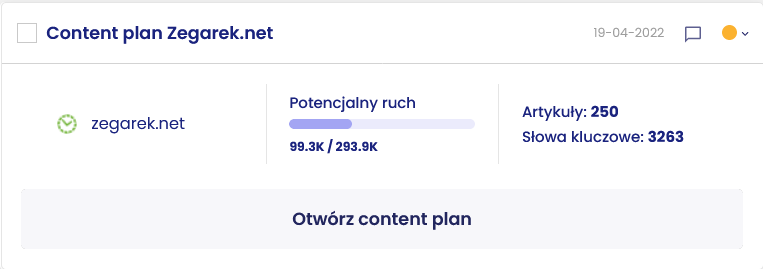
Short explanation of the above image:
The tool generated a plan with 250 articles to cover 3263 keywords. The total traffic these articles can bring from Google is close to 300,000 visits per month.
The keywords included in the plan already have partial coverage on the Watch.net website, with about 2/3 of the total traffic potential left to be tapped. This can be seen in the middle cell.
Thus, from the statistics given, it can be seen that 250 articles published on the site can bring up to 200 thousand additional visits to the site per month.
In case anyone was wondering: this is a lot for a thematic e-commerce site. It is definitely worth fighting for. Besides, every even 1,000 more visits is strongly desirable, from a business point of view.
So let’s open a content plan to look at what kind of articles we should write or commission.
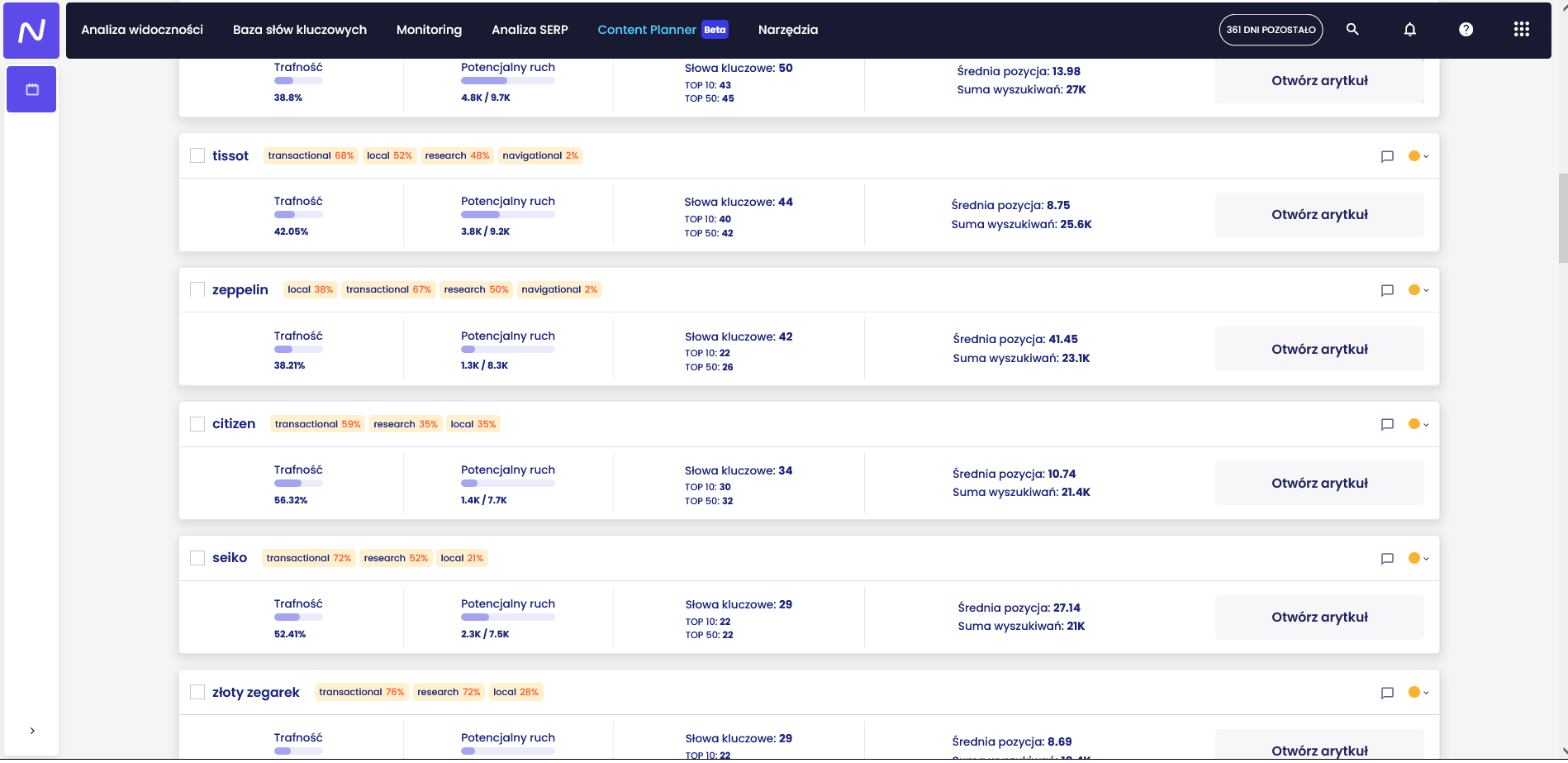 .
.
What an assignment for a copywriter (or for yourself)
should look like.
Suppose for a start I want to publish 3 new texts on the site. From the generated content plan, I choose articles with relatively high traffic potential to use:
- Tissot – potentially 5.4 thousand new visitors per month to be garnered from Google
- Zeppelin – potentially 7.0k
- Citizen – potentially 6.3 thousand
.
.
.
Let’s take a look at Citizen. After opening the article plan, I see a screen like this:
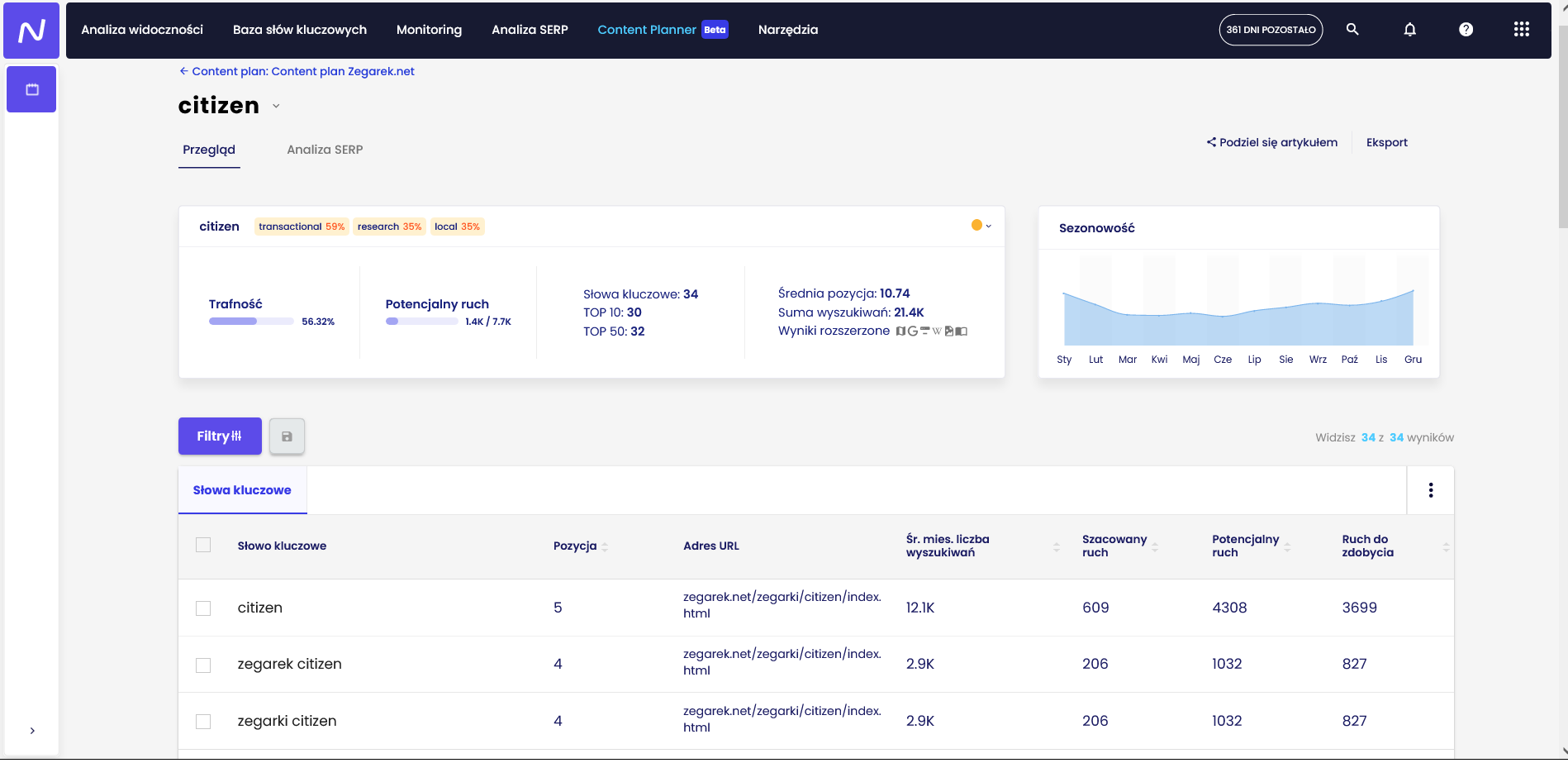 .
.
The Keywords table shows me for which phrases the Watch.net website is already visible in Google and in what position.
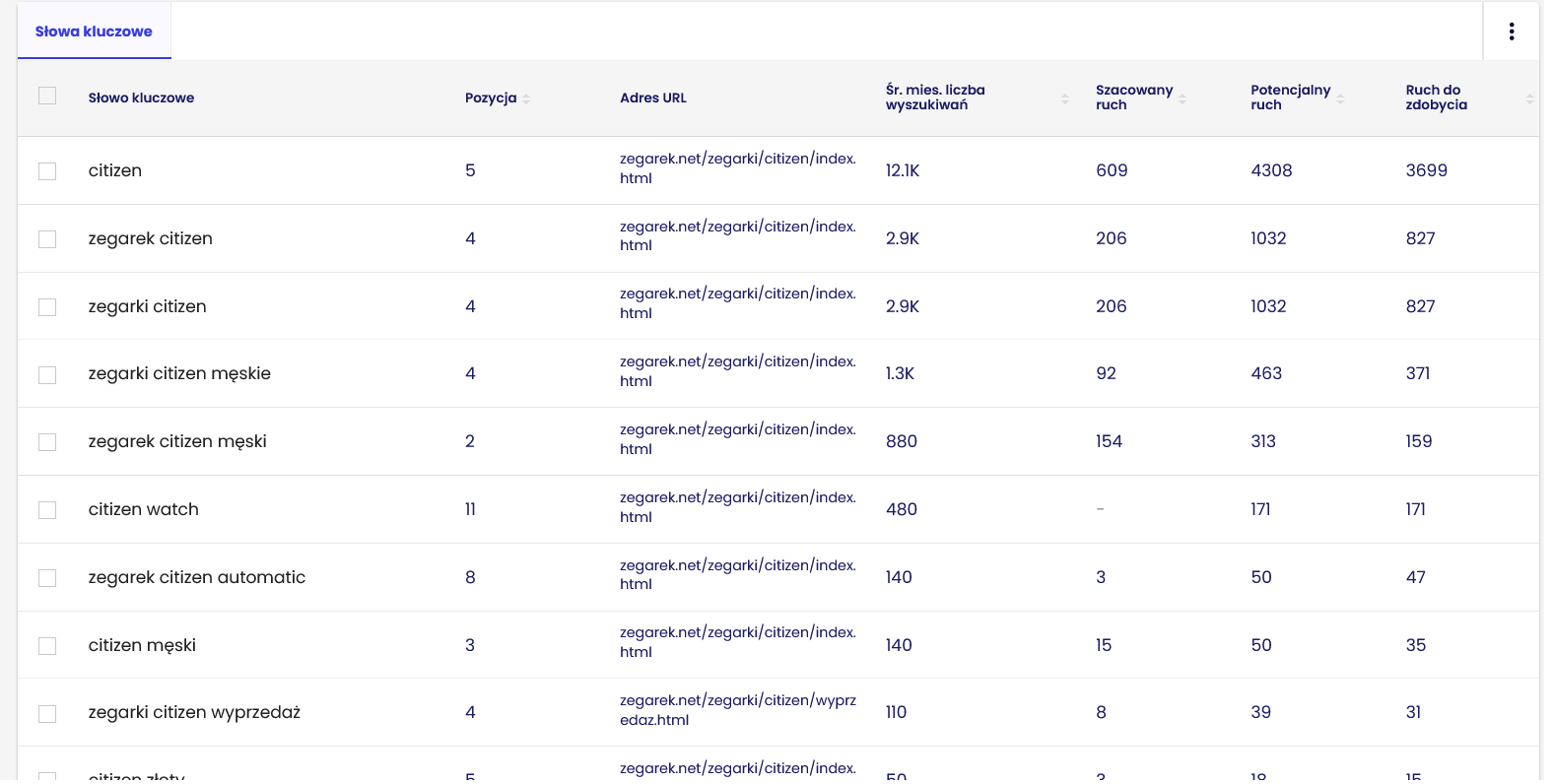
This is valuable information. If I focus more on these words – increase their density on the page, find additional context for them – then I have a chance for position increases, and therefore more traffic from the search engine.
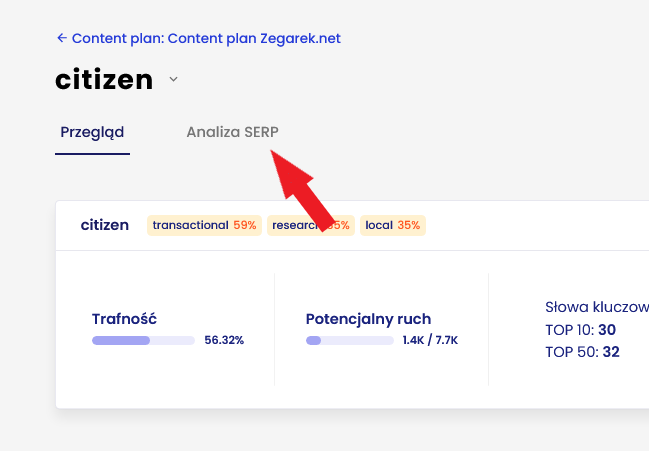
However, what is even more important in the context of a content plan is the SERP Analysis tab, where we will screen competitors’ materials that are high in Google.
The view is as follows:
Above the table we get the averaged length of the content, expressed in characters, as well as the number of higher (H2) and lower (H3) order headings.
And this is basically the essence if we want to write a new text on Citizen brand for the site.
We give the copywriter these guidelines along with a list of keywords (you can conveniently export them to an Excel file) and he can get to work.
The assignment could look like the following:
Please write a text about Citizen watches, 5300 characters long and including 2 mid-headings (H2) and 6 lower-order headings (H3). I am attaching a list of keywords that should be included in the text – please include them if possible. The text will be placed within the category description of the Watch.net store. For inspiration, I provide articles of competitors that rank high. Our goal, of course, is to rank higher ????.
- https://www.swiss.com.pl/pl/zegarki/citizen
- https://dolinski.pl/zegarki-citizen/
- zegarownia.pl/zegarki-citizen/zegarki-meskie-citizen
For the other two themes – Tissot and Zeppelin – the order will look similar. You just need to pull the keyword list and figures from Content Planner.

The description above demonstrates with a vivid example how to generate and read content plans using Content Planner. You may also find useful our official manual and the recording of the webinar, where Adam and Matthew demonstrated the tool’s features live.
Content plan is a game of maximizing the probability of success
.
An important note: there is no single perfect recipe for effective text. It is not the case that an article of 5300 characters will definitely rank better than one of 6300 characters.
Content Planner shows averages, but as you can see in the tool – the lengths of articles and the number of headlines they contain vary widely among competitors. The length of texts varies from a few hundred to tens of thousands of characters!
The point is that it is good to take some value. Have a meaningful reference point.
And such a reference point is the average values provided by Content Planner. Most likely, these would be values that an SEO specialist would also consider reasonable and have the article written based on them.
But even the best SEO specialist can’t be 100 percent sure how Google will treat the material. No one has a guarantee in this game, and no one can – because even Google’s own developers admit that they do not have full control over their own algorithms.
With a good content plan, we play for the highest probability of success. We create SEO-optimized materials that have the right length, headlines and, most importantly, keywords. This gives them a good chance of ranking higher in the search engine.
By executing the step-by-step content plan, invented by Senuto, we ensure tight coverage of a given topic on our site. This, in turn, is a way to give the site a high topical authority – a kind of trust factor that Google gives us.
This topical authority is not based on search engine sympathy, but simply on data. The better the data you have and the better you can translate it into text, the better a colleague Google will be for you.
And doing any business – watch or otherwise – you want that colleague on your side.
 Wojciech Maroszek
Wojciech Maroszek